Periodontics
- Tartar removal
- Root planning or smoothening
- Simple gum surgeries with Grafting
- Gummy Smile Correction
STAGES OF GINGIVITIS AND PERIODONTAL DISEASE
Did you know?
Gum disease is a common dental problem that may result in tooth loss. Gingivitis and Periodontitis are the most common types of adult gum disease.
HEALTHY GUMS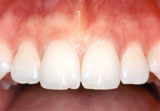
Healthy teeth and gums are maintained by daily plaque removal from all surfaces of the tooth (through tooth brushing and interdental cleaning)
The following features characterize healthy gums:
- Pink or coral pink color, (normal variations in color depend on race and complexion)
- Firm, resilient tissues
- 'Orange-peel' texture (known as stippling)
- Shape that follows the contour of the teeth and forms a scalloped edge
- No areas of redness, swelling or inflammation
- No bleeding during daily plaque removal
WHAT IS GINGIVITIS?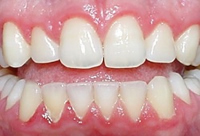
Gingivitis is inflammation of the gum tissue. The gums are irritated and swollen due to a plaque or calculus (tartar) buildup along the gumline. The gums may be sore, bleed easily and appear puffy, soft and swollen. No bone structure is lost around the teeth at this stage of gum disease. Blood on the toothbrush or dental floss is one of the earliest and most common signs of gingivitis. Your gums should never bleed while brushing or flossing. The good news about gingivitis is that it is preventable and reversible through good brushing and flossing techniques (or other interdental tooth cleansing). On the other hand, if oral hygiene habits are poor, gingivitis may progress to Periodontitis.
WHAT IS PERIODONTAL DISEASE?
Periodontal disease is destruction of bone and the structures supporting the teeth. Unfortunately Periodontitis is irreversible, but you can stop its progression through good oral hygiene and visiting your dental professional.
Eight Warning Signs of Periodontal Disease:
- Gums that bleed when you brush or floss your teeth
- Gums that are red, swollen or tender
- Gums that have pulled away from teeth
- Infection including purulence (pus) between the teeth and gums when the gums are pressed
- Permanent teeth that are loose or separating
- Any changes in the way your teeth fit together when you bite
- Any changes in the fit of your partial denture
- Bad breath
- Itchy sensation
EARLY AND MODERATE PERIODONTITIS: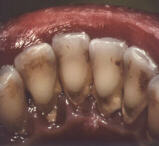
- Periodontitis occurs when the inflammation of the gums progresses into the deeper underlying structures and bone.
- In the most common form of Periodontitis, plaque (and sometimes calculus) is found below the gumline.
- The gums may feel irritated, appear bright red, and bleed easily.
- The ligaments holding the tooth in its socket break down and the gums pull away from the teeth, resulting in a periodontal pocket or space between the tooth and gum.
- The periodontal pocket deepens and fills with more bacteria. Supportive ligaments and bone start to show damage.
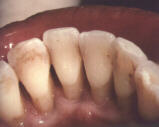 Calculus and plaque do not have to be evident to the naked eye for periodontal disease to be present. You need regular examinations performed by your oral health professional to assess your periodontal health and determine if periodontal disease is active in your mouth.After non-surgical periodontal therapy (i.e. scaling). The gums have been restored to health. Notice the gums have receded, exposing the root of the tooth. This is due to the irreversible bone loss as a result of previous periodontal disease. This can lead to tooth sensitivity.
Calculus and plaque do not have to be evident to the naked eye for periodontal disease to be present. You need regular examinations performed by your oral health professional to assess your periodontal health and determine if periodontal disease is active in your mouth.After non-surgical periodontal therapy (i.e. scaling). The gums have been restored to health. Notice the gums have receded, exposing the root of the tooth. This is due to the irreversible bone loss as a result of previous periodontal disease. This can lead to tooth sensitivity.
ADVANCED PERIODONTITIS: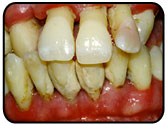
- When Periodontitis progresses to the advanced stage, the gums severely recede (pull away from the tooth); pockets deepen and may be filled with pus.
- There may be swelling around the root and you may experience sensitivity to hot or cold or feel pain when brushing your teeth. This is due to the severely receding gums exposing the root surface.
- As bone loss increases, your teeth may lose so much support that they need to be removed to preserve the overall health of your mouth.
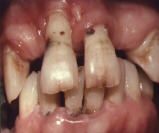 Advanced periodontal disease: further progression of Periodontitis with major loss of bone support. The teeth may lose so much support that they may be loose.Adult gum disease is usually not painful. It can progress slowly. You may not even be aware of it until the advanced stages, when the tooth is in danger of being lost. Check your gums thoroughly and regularly. It is also important to go for regular checkups (at an interval schedule determined through collaboration with your oral health professional, based on your own personal needs). Your dental hygienist can detect the early stages of gum disease, when it is the easiest to treat.Protecting your periodontal health brings many benefits. You can chew with more comfort. You can smile and speak with greater confidence. You can keep dental costs down by preventing further problems. A commitment to maintenance therapy is a commitment to better health.
Advanced periodontal disease: further progression of Periodontitis with major loss of bone support. The teeth may lose so much support that they may be loose.Adult gum disease is usually not painful. It can progress slowly. You may not even be aware of it until the advanced stages, when the tooth is in danger of being lost. Check your gums thoroughly and regularly. It is also important to go for regular checkups (at an interval schedule determined through collaboration with your oral health professional, based on your own personal needs). Your dental hygienist can detect the early stages of gum disease, when it is the easiest to treat.Protecting your periodontal health brings many benefits. You can chew with more comfort. You can smile and speak with greater confidence. You can keep dental costs down by preventing further problems. A commitment to maintenance therapy is a commitment to better health.